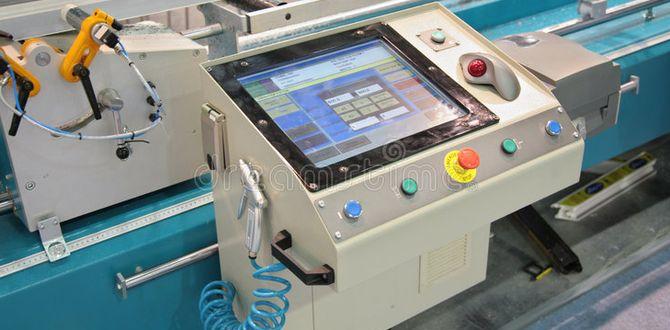Quick Summary:
A 50-degree TiAlN ball nose end mill is crucial for machining tough materials like Titanium Grade 5. Its specialized coating and shape allow for efficient heat dissipation and smooth material removal, especially in demanding applications like trochoidal milling, preventing tool breakage and ensuring a clean finish.
Working with titanium can feel a bit like wrestling a greased bear—slippery, tough, and prone to making things difficult! Many of you have asked about the best tools for tackling this challenging metal, especially when you want to get those smooth, curved cuts that only a ball nose end mill can achieve. It’s frustrating when your tools wear out too fast or leave a rough surface. But don’t worry, because the right tool makes all the difference. Today, we’re diving deep into a specific hero of the machining world: the 50-degree TiAlN ball nose end mill. You’ll learn why this particular tool is a game-changer for titanium, especially for techniques like trochoidal milling, and how it can make your machining smoother, faster, and much more successful.
Why Titanium is a Machining Headache (and How to Solve It)
Titanium is a fantastic material. It’s strong, lightweight, and resistant to corrosion, which is why it’s used in everything from aircraft components to medical implants. However, these amazing properties make it notoriously difficult to machine. It has low thermal conductivity, meaning heat builds up rapidly at the cutting edge, leading to tool wear and poor surface finishes. It also has high tensile strength and a tendency to “gum up” on cutting tools, causing chatter and increasing the load on your machine.
Think of it like trying to cut through a very dense rubber with a dull knife. The material deforms and grabs the blade, making it hard work. For machinists, this translates to:
- Rapid tool wear
- Catastrophic tool failure (broken tools)
- Poor surface finish on the workpiece
- Increased machining time and cost
- Stress on your milling machine
The key to overcoming these challenges lies in a combination of proper machining parameters (speeds, feeds, depth of cut) and, crucially, the right cutting tool. This is where our specialized end mill comes into play.
Introducing the 50-Degree TiAlN Ball Nose End Mill: Your Titanium Ally
Let’s break down what makes a “50-degree TiAlN ball nose end mill” so effective for titanium. Each part of that name tells a critical story about its design and function.
The Ball Nose Shape
A ball nose end mill, as the name suggests, has a rounded or hemispherical tip. This is different from a flat-end mill which has a square tip. The rounded tip is essential for several reasons when working with titanium:
- Smooth Contouring: The rounded shape allows for seamless creation of complex curved surfaces, fillets, and pockets. This is vital for aerospace parts, molds, and artistic machining.
- Reduced Stress Risers: Unlike sharp corners, a radius can distribute stress more evenly, which is important for the integrity of the machined part.
- Heat Dissipation: The curved flute geometry helps to evacuate chips more efficiently. In materials like titanium, good chip evacuation is paramount for preventing heat buildup.
The 50-Degree Helix Angle
The helix angle refers to the angle of the cutting flutes around the tool’s body, similar to the threads on a screw. Standard end mills often have helix angles of 30 or 45 degrees. A 50-degree helix angle on a ball nose end mill is a bit more advanced and offers specific advantages for tough materials like titanium:
- Increased Shear Strength: A steeper helix angle (like 50 degrees) allows for a more aggressive cutting action. It slices through the material rather than rubbing against it, which is ideal for titanium’s gummy nature.
- Improved Chip Evacuation: The steeper angle helps to lift and throw chips away from the cutting zone more effectively, preventing chip recutting and reducing heat.
- Smoother Finish: While it might seem counterintuitive, a steeper helix can often lead to a smoother surface finish in gummy materials because it promotes continuous chip flow and less vibration.
- Reduced Cutting Forces: By slicing more cleanly, it can reduce the force required to cut, which is easier on your machine and the tool.
The TiAlN Coating (Titanium Aluminum Nitride)
This is perhaps the most critical feature for titanium machining. TiAlN is a multi-layer coating applied to the surface of the end mill. It’s not about making the tool look pretty; it’s a high-performance enhancement that:
- Increases Hardness: TiAlN coatings are extremely hard, providing significantly increased wear resistance. This means the cutting edge stays sharp for much longer.
- Improves Heat Resistance: Titanium is prone to generating high temperatures during cutting. TiAlN can withstand temperatures up to 800°C (1472°F), creating a thermal barrier between the cutting edge and the workpiece. This prevents the tool from softening and degrading.
- Reduces Friction: The coating acts as a lubricant, reducing friction between the tool and the workpiece. Less friction means less heat and less tendency for the material to stick to the tool.
- Prevents Oxidation: At high temperatures, materials can oxidize. TiAlN helps to prevent this, maintaining the cutting edge’s integrity.
- Ideal for Dry Machining: Its heat resistance makes it excellent for dry milling operations, which are often preferred for titanium to avoid coolant contamination issues or when using flood coolant is impractical.
In simple terms, the TiAlN coating is like giving your end mill a super-tough, heat-proof shield that helps it slice through titanium without getting bogged down or melting.
Trochoidal Milling: The Perfect Partner for Your TiAlN Ball Nose End Mill
Now, let’s talk about a machining strategy that perfectly complements our specialized end mill: trochoidal milling. If you’re working with titanium, you’ve likely encountered issues with deep pockets or long slots where heat and chip buildup become major problems, leading to tool breakage.
Trochoidal milling, also known as high-speed milling or dynamic milling, is a technique that uses a small step-over (the lateral distance the tool moves) and a large axial depth of cut. Instead of taking one large bite, the tool follows a circular or serpentine path, continuously engaging a small amount of material. This looks a bit like a tiny race car doing constant sharp turns within the pocket.
Here’s how it works and why it’s so effective, especially with a 50-degree TiAlN ball nose end mill:
- Controlled Chip Load: By taking a small radial engagement (step-over), you ensure that the chip load per tooth remains consistent and manageable. This prevents the tool from being overloaded.
- Constant Coolant Flow (if used) / Air Blast: With a small radial engagement, coolant or air can more easily reach the cutting zone, helping to flush chips and cool the cutting edge.
- Reduced Heat Buildup: Because the tool is constantly moving and only engaging a small amount of material at any given moment, heat doesn’t have a chance to build up to damaging levels.
- Continuous Chip Evacuation: The dynamic path helps to break up chips and ensures they are efficiently cleared from the flute, preventing recutting.
- Reduced Cutting Forces: The continuous, flowing motion means the cutting forces are more consistent and less likely to cause vibration or chatter.
- Maximizes Engagement Time: Even with a small step-over, the tool is almost always cutting, leading to faster overall material removal rates compared to traditional pocketing methods in tough materials.
The 50-degree helix angle of our end mill is perfect for this because it promotes aggressive cutting and efficient chip evacuation needed for trochoidal paths. The ball nose shape allows the tool to smoothly transition through its trochoidal movements without creating sharp corners that could snag, while the TiAlN coating handles the inevitable heat and wear.
For more information on these advanced milling strategies, resources like IMTS’s Advanced Manufacturing Glossary offer excellent definitions and insights into terms like trochoidal milling.
Choosing the Right Titanium Grade
While this article focuses on the tool, it’s important to remember that titanium isn’t just titanium. Different grades have slightly different properties. The most common grade for general machining and many industrial applications is Titanium Grade 2, often referred to as commercially pure titanium. However, for higher strength and hardness, Titanium Grade 5 (Ti-6Al-4V) is extremely popular, especially in aerospace and sports equipment. Grade 5 is significantly harder and more challenging to machine than Grade 2.
A 50-degree TiAlN ball nose end mill is particularly beneficial for Grade 5 titanium due to its tougher nature. The robust coating and aggressive helix angle are better equipped to handle the increased cutting forces and heat generated when machining this alloy.
Practical Considerations for Using Your TiAlN Ball Nose End Mill
Simply having the right tool isn’t enough. You need to use it correctly to get the best results and ensure its longevity. Here are some key points to keep in mind:
Speeds and Feeds: The Golden Numbers
Finding the perfect speed and feed rate can be tricky and depends on several factors, including your machine’s rigidity, the specific titanium alloy, the coolant you’re using (if any), and the exact dimensions of your end mill.
As a starting point for Titanium Grade 5 with a TiAlN coated ball nose end mill, you might consider:
- Surface Speed (SFM): Often in the range of 20-60 SFM. This is a lot lower than for steel or aluminum.
- Chip Load per Tooth (CLPT): This is crucial for trochoidal milling. It might be as low as 0.001″ – 0.003″ per tooth.
- Spindle Speed (RPM): Calculated as (SFM 4) / Diameter (in inches). So, for a 1/2″ end mill at 30 SFM, it would be (30 4) / 0.5 = 240 RPM.
- Radial Step-over: Typically 10-25% of the tool diameter for dynamic milling.
- Axial Depth of Cut: This is where you can be more aggressive, but it depends on the machine and tool holder rigidity. Start conservatively, perhaps 1-3 times the tool diameter or more if your setup is very rigid.
Important Note: Always consult the end mill manufacturer’s recommendations. They often provide starting point data for various materials.
Coolant and Lubrication
Machining titanium is a high-heat process. While TiAlN performs well at high temperatures, actively managing heat is still essential.
- Flood Coolant: A high-pressure, high-volume flood coolant system is ideal. A 5-10% solution of a sulfur-free synthetic or semi-synthetic coolant is often recommended for titanium.
- Minimum Quantity Lubrication (MQL): This MQL system injects a fine mist of lubricant directly into the cutting zone. It’s highly effective for titanium and keeps both the tool and workpiece cool without flooding the machine.
- Air Blast: In some cases, a strong blast of compressed air can help, especially for chip flushing, but it’s less effective at cooling than liquid coolants.
- Dry Machining: The TiAlN coating makes dry machining possible, but it’s often at the expense of tool life and surface finish compared to using a coolant. Use this as a last resort or for very light cuts.
For best results with titanium, especially for extended operations, a robust coolant strategy is highly recommended. A great resource for understanding metalworking fluids is the Association for Manufacturing Technology (AMT), though specific product recommendations should come from lubricant suppliers.
Tool Holder Rigidity and Runout
A worn or low-quality tool holder can introduce runout (the wobble of the cutting tool). In titanium machining, runout is disastrous. It leads to uneven cutting, increased vibration, poor tool life, and broken tools. Ensure you are using a high-quality, precisely ground tool holder, such as a hydraulic chuck or a shrink-fit holder, for the best concentricity.
Machine Rigidity
Your milling machine needs to be rigid enough to handle the cutting forces. A light-duty hobby machine might struggle with aggressive titanium cuts, even with the best tools. Ensure your machine is clean, well-maintained, and can handle the loads without excessive vibration. Table locks, if available, can sometimes add beneficial rigidity.
Benefits of Using the Right Tool (Table Comparison)
To really drive home why the 50-degree TiAlN ball nose end mill is so important, let’s look at a comparison. Imagine you’re trying to machine Titanium Grade 5 in a deep pocket. Here’s what might happen with different tool choices:
| Feature/Tool | Standard Ball Nose End Mill (e.g., HSS, no coating, 30° helix) | TiAlN Coated Ball Nose End Mill (30° helix) | 50° Helix TiAlN Coated Ball Nose End Mill |
|---|---|---|---|
| Material Compatibility | Poor to Fair | Good | Excellent (especially for Grade 5) |
| Heat Resistance | Very Low | Good | Excellent |
| Wear Resistance | Low | Good | Very Good |
| Chip Evacuation | Fair | Fair to Good | Excellent |
| Cutting Forces | High | Moderate | Lowest (enables aggressive cuts) |
| Tool Life Expectancy | Very Short | Moderate | Longest |
| Surface Finish Potential | Poor (gouging, melting) | Fair to Good | Best (smooth, clean) |
| Success with Trochoidal Milling | Low (prone to breakage) | Moderate | Highest (optimal performance) |
As you can see, the combination of the TiAlN coating and the 50-degree helix angle in a ball nose end mill provides superior performance for challenging materials like titanium. It’s an investment that pays off in longer tool life, better finishes, and fewer headaches.
When is a 50-Degree TiAlN Ball Nose End Mill Absolutely Essential?
While it’s a fantastic tool for general titanium machining, there are specific scenarios where it’s not just recommended, but essential:
- Machining Titanium Grade 5 (Ti-6Al-4V): Its hardness and strength demand the superior properties of this tool.
- Deep Pocketing and Slotting: Especially when using trochoidal or dynamic milling strategies to manage heat and chip load.
- High-Volume Production: When tool life and efficiency are critical for profitability.
- Aerospace and Medical Components: Where precision, surface finish, and material integrity are paramount.
- High-Speed Machining Environments: Where the tool needs to withstand rapid material removal and associated stresses.
- When Using Less-Than-Ideal Coolant: Its heat resistance helps compensate if you can’t flood the workpiece effectively.
Common Mistakes to Avoid
Even with the best tool, mistakes can happen. Here are a few common pitfalls to steer clear of when machining titanium with your 50-degree TiAlN ball nose end mill:
- Running too fast: Titanium requires slower surface speeds than many other metals. Pushing your RPM too high will quickly overheat and destroy the tool coating and edge.
- Taking too large of a radial step-over: This is a recipe for tool breakage, especially in deep cuts. Stick to appropriate percentages for trochoidal milling.
- Not using enough coolant (or the wrong type): While TiAlN is tough, it’s not invincible. Proper cooling is still vital for optimal performance and tool life. Avoid coolants with sulfur if possible, as they can react with titanium.
- Using a dull tool: Always ensure your tool is sharp. A dull tool will rub, generate more heat, and require more force, leading to poor results.
- Lack of rigidity: Trying to cut titanium with a flimsy setup will result in chatter, poor finish, and likely broken tools.





